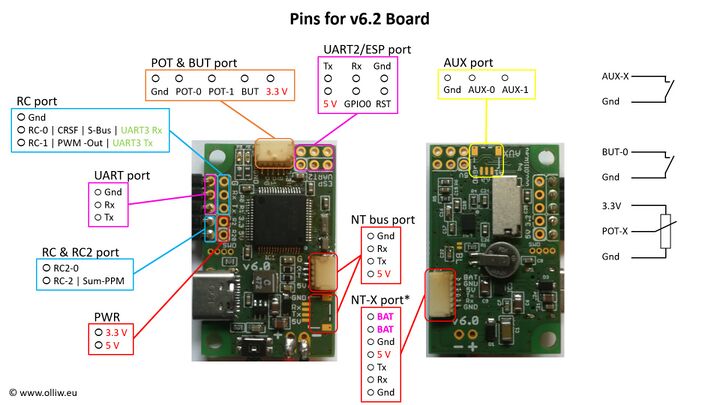"Original" STorM32 Boards
At present, board versions v6.x are supported (v0.17/v1.0, v1.1, v1.2, v1.3x, v2.4, v3.3, v4.1 boards are not supported).
The STorM32 boards offer two types of NT bus ports, the NT and NT-X ports. Both of these ports differ from the NT bus connectors on the NT modules in that their Rx and Tx pins are swapped.
Comment: The Rx, Tx pins of the NT and NT-X ports on the STorM32 board must be connected to the Tx, Rx pins on the NT modules.
In addition to the boards shown here, also other variants exist, such as e.g. micro versions.
Design schemes are located in https://github.com/olliw42/storm32bgc.
STorM32-BGC v6.3
- MCU: STM32H7A3RG at 280 MHz
- motor drivers: DRV8839
- voltage regulator: 5 V, 2 A (??) switching regulator
- on-board IMU: ICM42688P/ICM42688V
- 2x NT port and 1x NT-X port
- USB-C connector, VCP & DFU
- UART2/ESP port
- CRSF, Futaba S-Bus
- Sum-PPM, 4x PWM inputs, 1x PWM output
- joystick port (analog) for two axes
- 2 auxiliary ports (digital), BUT port (digital)
|
- supply voltage: 6 - 12 V or 2 - 3S (with motor drivers enabled)
Comment: The motor drivers are enabled by closing the JP1 solder bridge on the bottom side of the board. When the solder bridge is open (motor drivers disabled), the board can be used with voltages up to 27 V or 6S.
- motor current: 1.0 A (??)
- board dimensions: 40 mm x 28 mm, 35 mm bolt to bolt, holes Ø3 mm
|
Comment: This board is design of Gohstand Designs and based on the v4.1 design of KrattWorks.
The JP1 solder bridge is on the bottom side of the board. When closed: The motor drivers are connected to VBat and are functional. The voltage shall then not exceed 12 V or 3S. When open: The motor drivers are disabled and non-functional; the voltage can then be up to 27 V or 6S.
STorM32-BGC v6.2
- MCU: STM32H7A3RG at 280 MHz
- motor drivers: none
- voltage regulator: 5 V, 2.0 A low-noise switching regulator
- on-board IMU: ICM42688P/ICM42688V
- 2x NT port and 1x NT-X port
- USB-C connector, VCP & DFU
- UART2/ESP port
- CRSF, Futaba S-Bus
- Sum-PPM, 4x PWM inputs, 1x PWM output
- joystick port (analog) for two axes
- 2 auxiliary ports (digital), BUT port (digital)
|
- supply voltage: 6 - 27 V or 2 - 6S
- motor current: depends on used NT motor modules
- board dimensions: 40 mm x 25 mm, 35 mm bolt to bolt, holes Ø3 mm
|
Comment: This board has no motor drivers; NT motor modules are thus mandatorily required.

